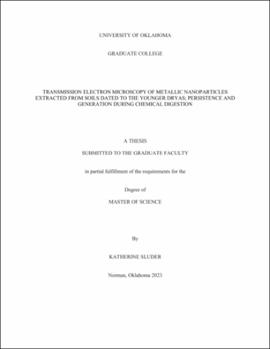| dc.description.abstract | Impact events are associated with nanodiamonds. Often found within meteorites, or produced from the interaction with earth’s environment, they can be found across sedimentary layers that record impact events. Acid digestion is typically used to separate nanodiamonds from these sedimentary layers, methods vary from group to group as do their results. As one example, Bement et al. (2014) found nanoparticles consistent with n-diamond in sediments dated to the Younger Drays boundary (YDB) in Bull Creek, OK. This is just one of 22 sites and counting that have identified nanodiamonds within YDB soils globally, suggesting a potential impact layer. Identifying nanodiamonds from heterogeneous geomaterials presents a number of challenges, including possible misidentification via Transmission Electron Microscopy (TEM) due to similarities with copper nanoparticles. For example, Bement et al. (2014) used copper TEM sample support grids, which leads to background signal contamination when using X-ray analysis (EDXA). Additionally, copper and n-diamond have d-spacings that differ by less than 1% making electron diffraction (SAED) an unreliable tool to characterize them (Daulton et al., 2017). In this study, we sought to provide additional evidence on the characterization of nanoparticles found in Bull Creek, OK. Using TEM and wet chemical analysis, we examine the potential for the destruction, production, and perseverance of metallic nanoparticles during the soil digestion process. Through this study we found that copper nanoparticles persisted throughout soil digestion methods and gold nanoparticles were generated during chemical digestion and altered under the electron beam in the TEM. We found that gold grids produced an abundance of nanoparticles when exposed to an acidic dichromate digestion matrix compared to other types of metallic grids (molybdenum and nickel). In comparison, molybdenum grids were destroyed by the matrix and nickel grids appeared unchanged, without nanoparticle deposition. Although we cannot rule out copper or diamond due to the abundance of gold nanoparticles across our sample grids, we have demonstrated the complex interactions between metallic nanoparticles and chemical digestion methods. | en_US |

